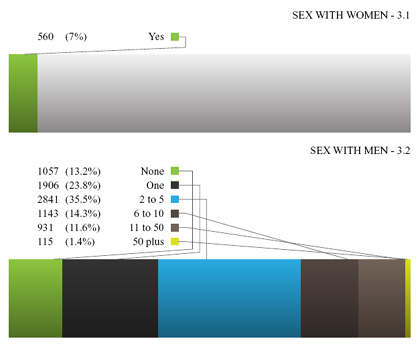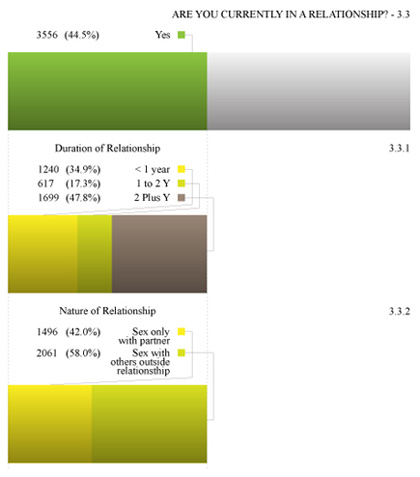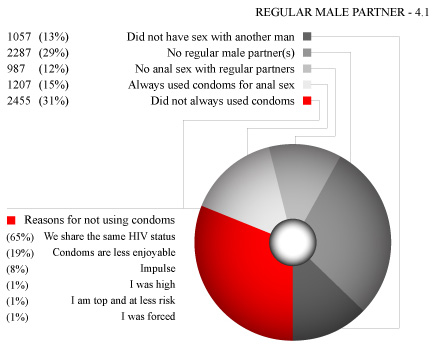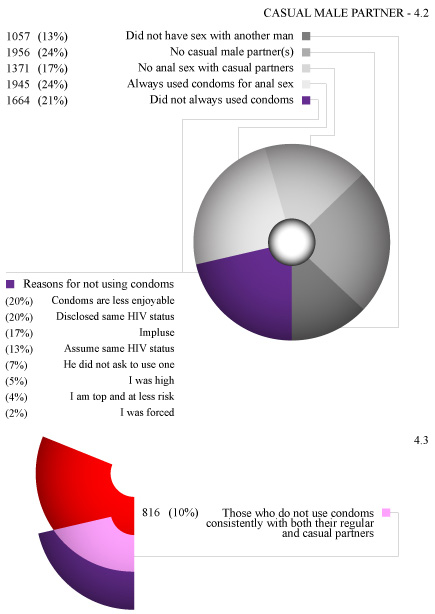Fridae.com 2009 MSM Sex Survey – Final Report

Methodology
In March and April 2009, an English language survey was conducted online (www.msmsexsurvey.com) and marketed through a network of community partners across Asia. 7993 MSM and TG completed the questionnaire about demographics, risk behaviour, HIV testing and acceptance. The questionnaire had over 140 questions, and took an average of 8 minutes to complete.
General demographics
The average age of respondents was 33 years (range 15-74). Most of the participants live in Singapore, Malaysia, USA, Australia, Hong Kong, Thailand and China. 5387 (67.4%) reported university education or higher.
Identity & socialisation
6558 (82%) of the respondents were gay-identified, and 1221 (15%) bisexual. 644 (8.1%) reported being uncomfortable with their sexuality, and 247 (3.1%) had no gay friends.
Sex & relationships during the past 6 months
560 (7%) had sex with a woman in the past 6 months. During this period, 1057 (13.2%) did not have any male sexual contact, 1906 (23.8%) had one partner, 2841 (35.5%) had 2 to 5 partners and 2189 (27.3%) had 6 or more partners.

3356 (44.5%) of the respondents are currently in a relationship. Of these, 1699 (48%) were for more than 2 years, and 1496 (42%) were sexually exclusive (sex only with one regular partner).

Sexual behaviour during the past 6 months
For male to male sex, the survey differentiated between regular (boyfriends and lovers), casual, and commercial sex partners. After excluding those who a) did not have any male sexual contact; b) did not have any male partners in the respective categories; c) did not have anal sex and; d) always used a condom for anal sex, it showed that 2455 (31%) of the respondents were not using condoms consistently with a regular male partner, and; 1664 (21%) were not using condoms consistently with their casual male partners. 816 (10%) did not use condoms consistently with both their regular and casual partners. 253 (3%) of respondents did not use condoms consistently with their commercial sex partners.


Unprotected anal sex amongst men in regular relationships is high
(2455 of 3556 in a current relationship do not use condoms consistently).
This is a cause for concern when either or both partners is also having
unprotected anal sex with casual partners (816 of 3556). This puts not
only themselves, but also their regular partners at risk.
The main reasons for regular partners to forego condom use was both partners share the same HIV status (positive or negative), and because they felt condoms made sex less enjoyable. For casual partners, 20% did not use condoms after disclosing their HIV status, 17% on impulse, 13% assumed the other person’s HIV status was the same as their own, and 7% because their partner did not ask to use one. Only 5% said being “high” was a reason for not using condoms.
Venues for meeting men
The Internet was the most common way for respondents to meet other men for sex (4936, 72%), followed by saunas (2615, 38%) and bars and clubs (1938, 28%).
Sexually transmitted infections, drugs & travel
3873 (48%) of respondents had an STI test in the past 6 months, and 1958 (24%) were diagnosed or treated for an STI during that period. 1050 (13%) reported consuming recreational drugs (e.g. Viagra, ecstasy, poppers, methamphetamines) for sex.
5121 (64%) of respondents travelled to a foreign country in the past 6 months, during which 2096 (41%) of them had protected anal sex and 506 (10%) had unprotected anal sex with a casual partner they met on their travels. 1098 (21%) attended a circuit or dance party.
HIV testing
2039 (26%) of respondents have never had an HIV test, with 4066 (51%) taking a test in the past 12 months. Of the 2039 who have never been tested, 46% reported a low personal risk assessment as the reason for not getting a test. Conversely, 14% felt it was likely they were already positive, and 30% either did not want to think about it, or were worried about confidentiality of the test results, and the stigma and discrimination they would face if tested positive. 9% did not know where they could go for a test.
Of the 5954 who have had an HIV test, 295 (5%) self-reported as HIV positive. Of these, 184 (62%) are currently on anti-retroviral treatment, and 150 (51%) have achieved an undetectable viral load. 135 (46%) of the positive MSM are currently in a relationship, 40 (30%) of which are with another HIV positive man.
Disclosure
Whilst 5177 (65%) of those surveyed felt that the best time to discuss one’s HIV status was before sex, only 1643 (21%) actually did so.
HIV acceptance
3109 (39%) of those surveyed personally knew someone who was HIV positive (friend, partner, co-worker, family member). Acceptance of HIV positive people was generally high, with most people willing to befriend, care for, and work with someone HIV positive. 2439 (31%) would also have sex with someone who had disclosed their positive status to them, and 1115 (14%) have already ever had sex with someone they knew was positive.
Conclusions
1. Not all MSM and TG are at equal risk for HIV infection. Men who abstain from sex, do not have anal sex, or use a condom consistently with all their sex partners when they have anal sex are at little to no risk of being infected with HIV.
2. Those most at immediate risk are the 21% of men who have unprotected sex with casual partners (1664 of 7993) and 3% with commercial partners (253 of 7993).
3. Unprotected anal sex amongst men in regular relationships is high (2455 of 3556 in a current relationship do not use condoms consistently). This is a cause for concern when either or both partners is also having unprotected anal sex with casual partners (816 of 3556). This puts not only themselves, but also their regular partners at risk.
4. Recent HIV testing (within the last 12 months) was also low, and almost a quarter of those surveyed had never been tested. A significant number who have never been tested, or tested recently continue to have unprotected anal sex with casual partners (684 of 7993).
5. The level of HIV acceptance in the community is relatively high, but despite this, the degree of HIV disclosure remains low.
Caveats
The respondents of this survey are not a representative sample of the gay community. Risk behaviour varies widely between countries and demographic segments and needs further study.
To view or download the 2009 MSM Sex Survey report (in PDF), click onto http://www.msmsexsurvey.com.
